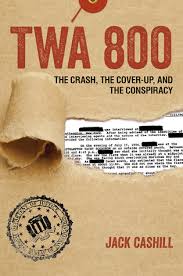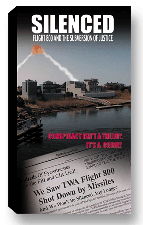Media Give Candace O the Joe Frazier Treatment
![]()

Order Jack Cashill's latest book, TWA 800: The Crash, the Cover-Up, and the Conspiracy
![]()

About Silenced: Flight 800
and the Subversion
of Justice (DVD) -
-Buy the Silenced DVD-
![]()
© Jack Cashill
April 10, 2019 - WND.com
For at least the last fifty years the media have been treating African Americans who reject left wing “values,” such as they are, as traitors to their race.
On Wednesday, congressional Democrats tried to frame conservative activist Candace Owens as they have framed many other ethnic renegades before her.
Owens would have none of it. The video of her fiery rebuttal has already been seen by millions. It speaks for itself.
With Owens at the hearing was her 75-year old grandfather of whom she spoke lovingly. On seeing him and hearing of his sharecropping background, I was reminded of boxing great Joe Frazier. Had he lived, Frazier would be 75-years-old today as well.
I thought of Frazier because he was framed much as Owens was. Tenacious as he was in the ring, Smokin’ Joe lacked the rhetorical skills to fight back outside the ring the way Owens did. What Frazier shared with Owens was the same adversary.
For those of short memory, it was in the 1960s that leftist sports reporters began to make their presence felt in America’s newsrooms.
Awash in their own righteousness, they introduced paralyzing concepts like “structural poverty” and “institutional racism” into the narrative to change the way sports stories were told.
In the traditional hero saga, the individual was expected to overcome hardship and injustice. In the new grievance narrative, he nursed them like grudges.
Declaring those grudges openly and often was the athlete’s way of aligning his interests with the media’s and announcing his faith as a newly christened denier of the American dream.
This shift in story-telling happened just in time to enable the hands-down ugliest instance of racial framing in sports history.
In much the same way Democrats in Congress tried to portray Owens as a friend of Adolph Hitler, The media transformed the twelfth child of a one-armed black South Carolina moonshiner into the chief spokesman for the Ku Klux Klan.
Although Muhammad Ali and his media acolytes would paint Frazier as “the great white hope” and worse, it is hard to imagine a more profoundly African experience in America than Frazier’s.
In almost every meaningful way, Joe Frazier led a “blacker” life than Ali. Most obviously, Frazier was conspicuously darker. He had proud Gullah roots, a black manager and trainer, and an integrated management team.
“I grew up like the black man—he didn’t,” Frazier would tell Sports Illustrated. “I cooked the liquor. I cut the wood. I worked the farm. I lived in the ghetto.”
In truth, if there was a great white hope in the epic battles between Frazier and Ali, it was Ali. In refusing the draft, Ali gave what biographer Mike Marqusee called a “major boost to the anti-war movement.”
Ali’s status as heavyweight champion removed some of the stigma attached to resisters as being unmanly or cowardly. Even more important, he helped dispel the “lily white image of the movement.”
A rebel Joe Frazier was not. From the perspective of Howard Cosell, the broadcaster most responsible for shaping the Ali myth, Frazier was just “a white man’s black man.”
As a proud Baptist, Frazier had no use for Ali’s Nation of Islam. And as a proud American, he thought this “a great country worth defending.”
The white people that mattered, the ones who controlled the switches and toggles of the broadcast media, colored Frazier white at the prodding of Ali, and they did this to insult Frazier. As Ali friend Jim Brown accurately observed, Ali had become “part of the establishment.”
With his greater rhetorical skills and his access to an increasingly friendly broadcast media, Ali painted Frazier into a corner. “Anybody black who thinks Frazier can whup me is an Uncle Tom,” said Ali at the time. “Everybody who’s black wants me to keep on winning.”
Future Today Show host Bryant Gumbel, then writing for Black Sport, asked in his headline, “Is Joe Frazier a White Champion in a Black Skin?”
Much as they would be do to Trump supporters, the media abused the people who pulled for Joe Frazier as much as they abused Frazier himself.
Fight manager and former sports editor Dave Wolf watched Ali on TV one night with Frazier. “The only people rooting for Joe Frazier,” he remembered Ali saying, “are white people in suits, Alabama sheriffs, and members of the Ku Klux Klan.” The media applauded Ali.
The image of Frazier fans has not appreciated much over time. “The people who wanted [Frazier] to beat Ali,” wrote biographer Marqusee in 2005, “were the die-hard racists, the love-it-or-leave-it brigade, the people who resented everything Ali stood for.”
Ali’s taunting of Frazier reached its nasty peak in the build-up to the pair’s third and final fight, “the Thrilla in Manila.”
Even before arriving in Manila, Ali had determined how best to undermine Frazier’s confidence. “He’d had me as a white man for the first two [fights],” recalled Frazier, “and now he was going to make me a cartoon of a nigger, a knuckle-scraping baboon-man. Gorilla. Frazier the gorilla.”
Or as Ali phrased it, “It will be a killer and a chiller and a thrilla when I get the gorilla in Manila.”
By this stage in his career, Ali owned the media. The psychic blows from this relentless assault bruised Frazier more deeply than all the punches of all the fights he ever fought.
“While the public found it amusing, I guess, and came to view [Ali] as a good guy,” remembered Frazier, “I knew different.”
As time passed, the media would elevate Ali to near sainthood. And as to Joe Frazier, they would remember him, when they bothered, as road kill along the way.
“I don’t fit the stereotype of what [the media] like to see in black people,” Candace Owens told congressional Democrats. “I will not pretend to be a victim in this country.”
If only Smokin’ Joe had Owens’s voice and platform.

